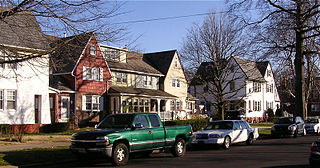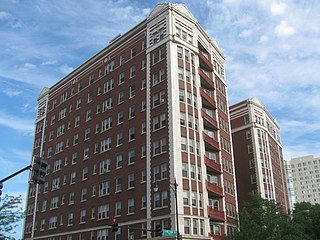
The history of Bridgeport, Connecticut was, in the late 17th and most of the 18th century, one of land acquisitions from the native inhabitants, farming and fishing. From the mid-18th century to the mid-19th century, Bridgeport's history was one of shipbuilding, whaling and rapid growth. Bridgeport's growth accelerated even further from the mid-19th century to the mid-20th century with the advent of the railroad, Industrialization, massive immigration, labor movements until, at its peak population in 1950, Bridgeport with some 159,000 people was Connecticut's second most populous city. In the late 20th century, Bridgeport's history was one of deindustrialization and declining population, though it overtook Hartford as the state's most populous city by 1980.

The Carl Mackley Houses, also originally known as Juniata Park Housing, is a private apartment complex in the Juniata neighborhood of Philadelphia, Pennsylvania. Built in 1933–1934 as single-family apartments, it opened in 1935. The project was sponsored by the American Federation of Full-Fashioned Hosiery Workers, with financing by the Housing Division of the Public Works Administration, of which it was the first funded project. The complex was named for a striking hosiery worker killed by non-union workers during the H.C. Aberle Company strike in 1930.

The Kennedy–Warren is a historic eleven-story apartment house in Washington, D.C. It is located at 3131–3133 Connecticut Avenue, N.W. between the Cleveland Park and Woodley Park neighborhoods. The Art Deco building overlooks the National Zoological Park and Klingle Valley Park, which is near the Art Deco Klingle Valley Bridge. The original main building was built between 1930 and 1931 with 210 apartments.

The Black Rock Gardens Historic District is a historic district in the Black Rock neighborhood of Bridgeport, Connecticut. It encompasses a small residential development built between 1916 and 1920 to provide housing for workers in war-related industries in the city. It is a well-preserved example of one of several such developments made in the city with funding by the United States Housing Corporation, a government agency. The district was listed on the National Register of Historic Places in 1990.

The Milner Arms Apartments, originally known as the Hotel Stevenson, is a high rise building located at 40 Davenport Street in Midtown Detroit, Michigan; it was listed on the National Register of Historic Places in 1997. It is adjacent to, but not part of, the Cass-Davenport Historic District.

The Cass–Davenport Historic District is a historic district containing four apartment buildings in Detroit, Michigan, roughly bounded by Cass Avenue, Davenport Street, and Martin Luther King, Jr. Boulevard. The district was listed on the National Register of Historic Places in 1997. The Milner Arms Apartments abuts, but is not within, the district.

The Cass Park Historic District is a historic district in Midtown Detroit, Michigan, consisting of 25 buildings along the streets of Temple, Ledyard, and 2nd, surrounding Cass Park. It was listed on the National Register of Historic Places in 2005 and designated a city of Detroit historic district in 2016.

The East Jefferson Avenue Residential District in Detroit, Michigan, includes the Thematic Resource (TR) in the multiple property submission to the National Register of Historic Places which was approved on October 9, 1985. The structures are single-family and multiple-unit residential buildings with construction dates spanning nearly a century, from 1835 to 1931. The area is located on the lower east side of the city.

The Harriman Historic District is located in the northern section of Bristol, Pennsylvania, United States. It is a 17-acre (6.9 ha) residential area with 109 buildings, mostly houses, and the local secondary school.

The Colonial Apartments are a historic apartment building at 51-53 High Street in Bangor, Maine. Built in 1919, it is one of the oldest and best-preserved apartment houses in the city that was marketed to a middle and upper-class population. The building was listed on the National Register of Historic Places in 2012.

The Winooski Block is a historic commercial building at 1 through 17 East Allen Street in downtown Winooski, Vermont. Built in 1867, it is the only major building to survive the city's urban renewal activities of the 1970s, and is a fine example of post-Civil War commercial architecture. It was listed on the National Register of Historic Places in 1974.

The Burritt Hotel was a historic hotel at 67 West Main Street in New Britain, Connecticut, United States. Built in the 1920s to attract business travelers, it was the city's most luxurious hotel. It is now Burritt House, an affordable housing complex. The building was listed on the National Register of Historic Places in 1983.

Historic Seaside Village Co-operative encompasses a primarily residential area in the South End of Bridgeport, Connecticut. It is bounded on the east by Iranistan Avenue, the north by South Avenue, the south by Forest Court and by the west by Alsace Street. The property consists of a densely built collection of brick rowhouses, arranged in irregular combinations. The village was developed during World War I to alleviate a housing shortage caused by an influx of workers hired to work in the city's munitions factories. It is a good example of an early government-funded project of this type, and was a collaborative design effort by R. Clipston Sturgis, Skinner & Walker, and Arthur Shurtleff. The district was listed on the National Register of Historic Places in 1990.

The Summit Apartment Building, also known as the Summit Street Cooperative Apartments, is a historic building located in Iowa City, Iowa, United States. This is the only known Iowa work of Chicago architect Parker Nobel Berry, a student of, and chief designer for, Louis Sullivan. The building is a stripped-down version of his original plan, which proved too expensive to build. The three-story structure follows a U-shaped plan, and is built on a raised basement. Completed in 1916, it was Iowa City's first apartment flat. The Prairie School-style building was built by local developer, Dr. Frank C. Titzell, who continued to own it until his death in 1932. His wife Bertha owned it until 1939 when she sold it to an out-of-state buyer. In 1947 it became the first Housing cooperative in the state after the Iowa General Assembly passed the Cooperative Housing Authorization Act earlier in the same year. The building was listed on the National Register of Historic Places in 1983.

The Marwood Apartments is an apartment building located at 53 Marston Street in Detroit, Michigan. It was listed on the National Register of Historic Places in 2019.

The East Park Towers are a historic apartment building at 5236-5252 S. Hyde Park Boulevard in the Hyde Park neighborhood of Chicago, Illinois. The building was constructed in 1922-23 during a period of residential growth in Hyde Park. While it had no guest rooms, the apartments offered similar amenities to an apartment hotel, such as housekeeping service. Apartment hotels were popular as part-time housing for wealthy workers, as they combined the amenities of in-home service with the affordability of apartments, and the East Park Towers were one of several such apartments built in Hyde Park at the time. Architect William P. Doerr designed the building in the Georgian Revival style; his design included terra cotta belt courses and quoins and Palladian windows on the first floor.

Ponce de Leon Apartments is a historic apartment building in Atlanta, Georgia, United States. A part of the Fox Theatre Historic District, the building is located at the intersection of Peachtree Street and Ponce de Leon Avenue in midtown Atlanta. It was built by the George A. Fuller Company in 1913, with William Lee Stoddart as the building's architect. The building was designated a Landmark Building by the government of Atlanta in 1993.

Great Lakes Manor, also known as Kirby Manor Apartments, is an apartment building located at 457 East Kirby Street in Detroit, Michigan. It was listed on the National Register of Historic Places in 2020.

The Gateway Village Historic District encompasses a World War I-era housing project on the east side of Bridgeport, Connecticut. Centered on Alanson Road, the project was developed in the later years of the war to provide emergency housing for workers in the city's munitions factories. It is a rared design attributed to the female-led architectural firm Mead & Schenk, and is an early example of Garden City movement design. It was listed on the National Register of Historic Places in 1990.

The Lakeview Village Historic District encompasses a historic World War I-era housing project on the east side of Bridgeport, Connecticut. Located northeast of Boston Avenue and west of Lakeview Cemetery, the development was built in 1918–20 to provide emergency housing for an influx of workers to the city's war production industries, and is a good early example of a Garden City movement subdivision. The district was listed on the National Register of Historic Places in 1990.






















